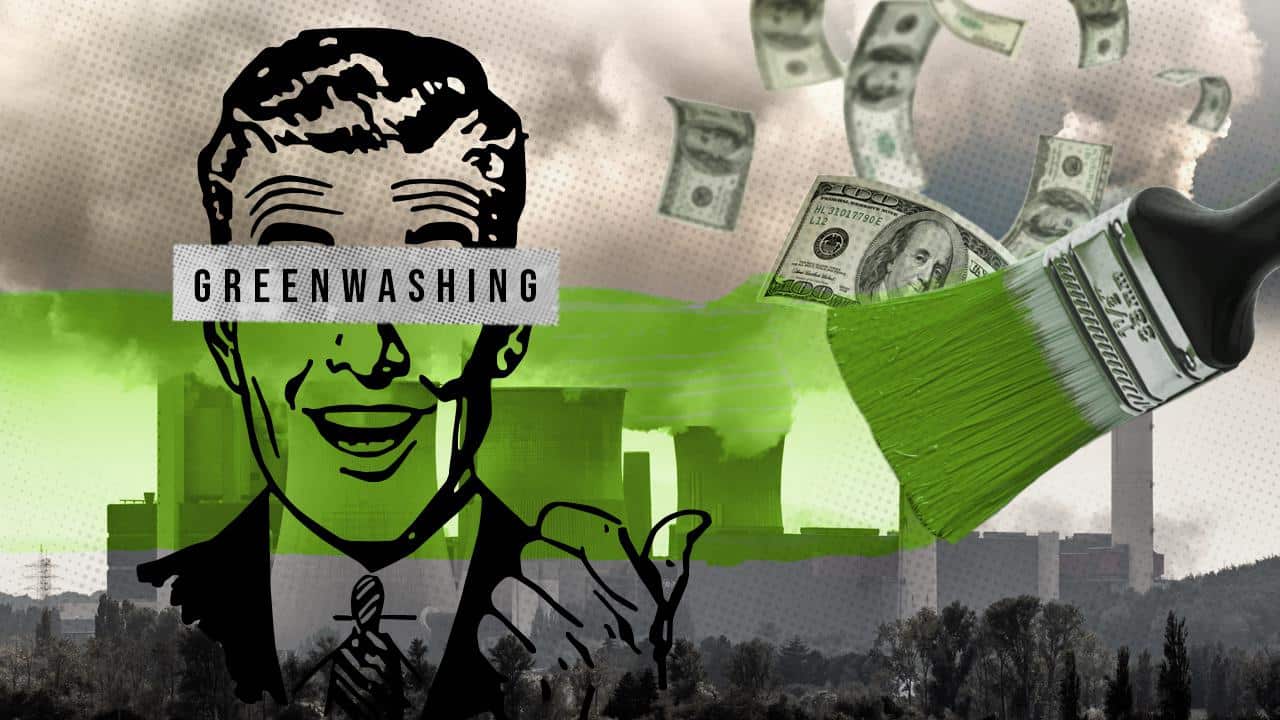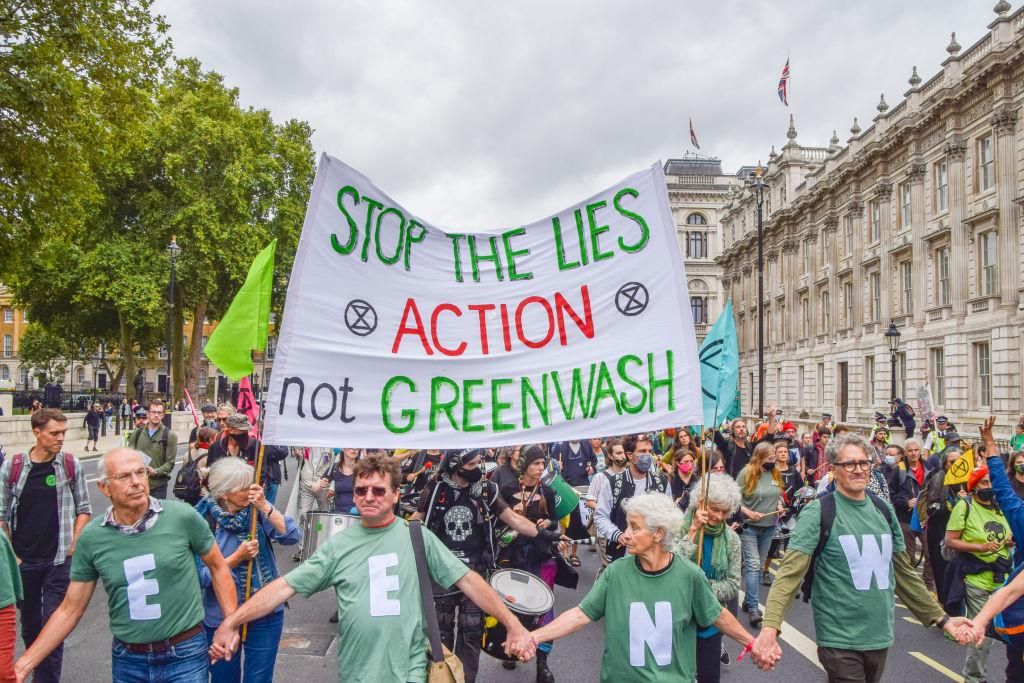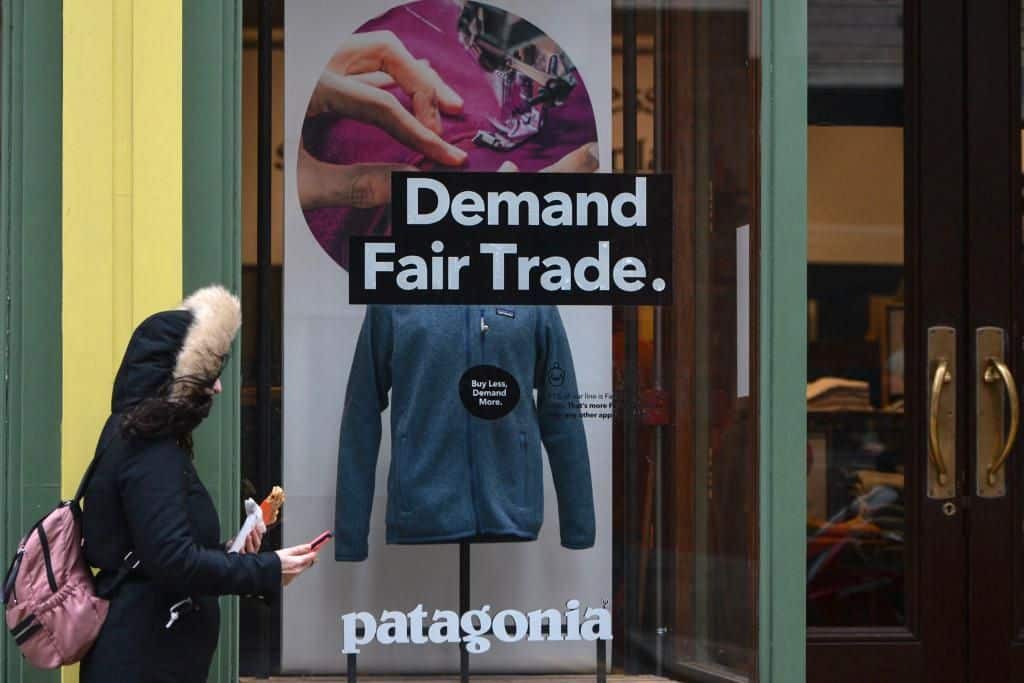A Guide to Greenwashing and How to Spot It

EcoWatch Illustration by Devon Gailey
 Why you can trust us
Why you can trust us
Founded in 2005 as an Ohio-based environmental newspaper, EcoWatch is a digital platform dedicated to publishing quality, science-based content on environmental issues, causes, and solutions.
If you care about the planet, you’re likely seeking ways to make environmentally responsible purchases. But, all your efforts to buy from companies that boast of making better choices for the environment might not have the benefit you believe.
In short, you might be falling victim to greenwashing. This shady advertising strategy is becoming a buzzword today, but what does greenwashing mean? Here, we’ll explore how to spot and avoid the common signs of greenwashing so you can make more informed buying decisions.
What Is Greenwashing?
“Greenwashing” is a common marketing ploy designed to make products seem more sustainable than they are. It’s essentially a way to convince customers that a company is making positive environmental choices, often through eco-conscious verbiage designed to convince shoppers that the product is more natural, wholesome, or free of toxins than competitors.
The term was first coined in the 1980s in an essay by environmentalist Jay Westerveld. In this essay, he criticized the hotel industry’s “save your towel” movement for preying on guests’ environmental sensibilities. While this movement was disguised as a way for guests to help hotels conserve water and save the planet, it essentially only cut down on laundry labor expenses for the hotel and made a minimal difference in water usage.
In this way, companies use greenwashing to appeal to customers who care about the environment without having to make meaningful changes in their business practices. It’s typical for greenwashing companies to spend far more time and money marketing the “eco-friendliness” of their products than on working to ensure they are sustainable.
Why is greenwashing so prevalent today? In short — because it works. A 2015 Nielson poll found that two-thirds of shoppers are willing to pay more for eco-friendly goods and that half consider a product’s sustainability before deciding whether to purchase.
Greenwashing’s Impact on Us

Protesters carry a banner while marching during an Extinction Rebellion demonstration outside in London. Vuk Valcic / SOPA Images / LightRocket / Getty Images
Greenwashing might sound harmless, but the reality is far worse. One problem is that it confuses consumers and distracts from actual eco-friendly initiatives.
Not all companies practice greenwashing maliciously. Often, it’s as much a misunderstanding on the marketers’ end as it is for customers. Even so, unintentional greenwashing still spreads false information about what it takes to be sustainable and can convince well-meaning customers to make bad choices.
Greenwashing and Single-Use Plastics
One prominent example of the problem with greenwashing is single-use plastics. More than 90% of plastic produced today is not recycled. Worse, much of it eventually lands in the ocean, where some estimate it will outweigh fish by 2050.
In light of these facts, many companies are working hard to change the reputation around their plastic products and boost consumer enthusiasm for them. Bioplastics give a potent example. Made from bio-based polymers instead of petrochemicals, this material is often considered good for the planet because it can break down thousands of years faster than traditional plastics. But what isn’t as commonly known is that these “natural” plastics need highly specific conditions to decompose that involve access to oxygen and sunlight — both of which are scarce in landfills.
Furthermore, many require the use of other plastics in the manufacturing process or even embedded within them to hold different components together. The benefits of using these materials are middling at best, which has led the FTC to challenge manufacturers on their misleading claims about their environmental impacts.
Single-use plastic water bottles have an even worse legacy. In 2008, Nestle came under fire by Canadian environmental groups for erroneously advertising that its bottled water benefited the environment with claims that “bottled water is the most environmentally responsible consumer product in the world.”
The same brand later introduced “Eco-Shape” bottles it advertised as containing up to 30% less plastic. A closer reading revealed this savings wasn’t compared to other versions of the product or even other water bottles, but instead of all forms of plastic bottles, including the much thicker bottles used for juice.
Other brands try to gain eco-friendly credibility in more subtle ways. Many labels include images of pristine mountain ranges or other green features to invoke a sense of purity and abundance without any manufacturing practices to back this up.
What Does Greenwashing Look Like?

Extinction Rebellion protesters dressed as ‘Greenwash Busters’ outside the Science Museum in South Kensington, during a protest. Vuk Valcic / SOPA Images / LightRocket / Getty Images
Greenwashing has evolved since the 1980s, and it’s becoming harder to spot to the untrained eye. Here are some of the signs to watch for when determining whether a brand is guilty of greenwashing.
Selective Disclosure: Companies often highlight positive environmental facts about their products while intentionally avoiding any mention of the negative. For example, an auto manufacturer might praise a vehicle’s fuel efficiency while ignoring the environmentally destructive mining practices involved in producing its lithium battery.
Symbolic Actions: It’s standard practice for brands to draw attention to a minor positive action that does little to change its overall environmental footprint. Oil companies donating Dawn dish soap to clean infected animals after their own product spills in the ocean is one example.
Hidden Trade-Offs: Brands may advertise a new change as green while ignoring its negative effects. For example, Starbucks introduced straw-free lids to avoid wasting plastic, but these new lids used more plastic than before.
Lack of Proof: The company may make claims about its eco-friendliness (“made with organic materials!”) without sharing certifications or other evidence to back them up.
Vagueness: Brands can greenwash by making broad statements filled with buzzwords about their sustainability that are too vague to mean anything. Examples include ‘new and improved, ‘non-toxic,’ and ‘made with biodegradable materials.’ Or, the package around a plastic toy might be labeled “recyclable” without making it clear whether it’s referring to the package, the toy, or minor components of either.
Irrelevance: Companies greenwash products by making claims that are technically true but irrelevant to their environmental impact. Examples are a paper company that boasts its products contain “all-natural materials” (most paper does) or an aerosol spray advertised as “CFC-free” (CFCs have been illegal in the US since 1978). This can also apply to trash bags labeled “recyclable,” as the entire purpose of these bags is to end up in the trash. The label implies an environmental benefit that would only be realized if users emptied their trash bags, rinsed them out, and then added them to the recycling after use.
Lesser of Two Evils: This happens when companies promote one beneficial aspect of an otherwise damaging product. Examples include fuel-efficient SUVs or Walmart getting sued for misrepresenting the benefits of “biodegradable” plastic bottles.
Meaningless Labels: Many brands hide behind meaningless “greenspeak” that sounds impressive but doesn’t have any official weight behind it. Examples include phrases like “made with natural ingredients” instead of showing USDA organic certification or saying “vegan approved” instead of showing the product is PETA-certified vegan.
Overinflated Phrases: Greenwashing companies may use phrases that, while technically true, give the consumer a skewed perception of the products they are buying. For example, an apparel company may state its shirts are “now made with 50% more recycled fibers” when increasing the amount from 2% to 3% of the total garment. True, but overstated as a benefit.
Suggestive Imagery: Sometimes, all it takes to greenwash is to market products in visually pleasing packaging. A tissue company might adorn its box with green leaves to imply the paper was harvested sustainably without mentioning that fact on the packaging. Some brands go so far as to incorporate small images that look like official logos for environmental certifications but are actually meaningless.
Corporate Examples of Greenwashing
Greenwashing has started to gain media attention in recent years. What large companies have been accused of greenwashing? Here are some noteworthy examples.
Auto Industry
Many car manufacturers give lip service to green transportation by improving their vehicles’ fuel efficiency or using recycled materials for the cars’ interior.
Some, like General Motors, also support the idea of tax credits for purchasing electric vehicles and have bold goals to only produce cars with zero tailpipe emissions by 2035. However, GM’s CEO, Mary Barra, is on the board of directors for Business Roundtable, an organization that lobbied hard against the climate initiatives presented in the Reconciliation Bill. In other words, the company is lobbying hard against the laws regulating emission standards they have publicly committed to meet.
Other companies are less discrete. In one notable case, Volkswagen admitted to cheating on its vehicles’ emissions tests by fitting cars with “defeat” devices to alter performance and reduce emissions when under testing conditions — all while the vehicles emitted up to 40 times the allowed limit of nitrogen oxide in real-world situations.
Apple
This global tech giant strives to have a positive public perception as a green company. However, many of the company’s “green” policies serve only to save money. The company announced in 2020 that its iPhone 12 would ship out without earbuds or a wall charger in order to cut down on e-waste.
While this measure is a step in the right direction, many critics saw it merely as a way to deflect attention to the company’s real source of e-waste — planned obsolescence. The brand’s phones are notorious for being expensive to repair and stop being supported by developers only a few years after release.
Amazon
As one of the most influential retailers worldwide, Amazon sets the standard for many global green initiatives. In recent years, the company has come under fire for making public proclamations about doing better for the environment, but quietly supporting legislation that undermines these efforts.
Amazon won the naming rights for a stadium in Seattle, which it named the “Climate Pledge Arena” in honor of it being the world’s first net-zero carbon certified arena. The company itself signed a Climate Pledge in 2019 with a public goal of hitting net-zero carbon emissions by 2040. However, this Pledge failed to show the concrete steps the company would take for this goal. Worse, the fine print showed it only covered Amazon’s direct operations rather than the carbon footprint of its supply chain, which accounted for more than 75% of the company’s emissions.
The company has also introduced a “Climate Pledge Friendly” badge on products that are certified Fair Trade, certified by the Rainforest Alliance, or other environmental certifications. However, some of the products earning this designation are clearly not eco-friendly, including single-use batteries, disposable baby wipes, and food products that contain palm oil sourced from endangered rainforests.
Shein
While Shein may be known as the quintessential online storefront for fast fashion, the company has been working to change its reputation for creating disposable clothing.
In one recent campaign, Shein highlighted its small-batch release process of just 50-100 items per style at a time to ensure there is demand before committing to large-scale production. The company also mentions its environmentally-conscious fabric printing process, automated water and power use in warehouses and incentivized clothing recycling programs at college campuses.
However, these claims are all unsubstantiated and the company shows little evidence of third-party verification for them. By using phrases like “we do our best to source recycled fabrics,” Shein can imply good intent without any follow-through. Vague claims without real numbers or documentation attached to them mean that Shein’s sustainability page uses many words to say very little.
Green Marketing vs. Greenwashing: What’s the Difference?
Looking at case studies of greenwashing corporations, it’s easy to assume that every company that claims to do right by the environment is hiding the truth. In reality, many businesses are making strides to make environmentally conscious choices, and their advertising campaigns reflect this. This is known as green marketing.
Here are some of the signs of a green product:
- Products are manufactured sustainably
- Items arrive with minimal packaging
- Free of toxic materials
- Able to be recycled or made from recycled materials
- Made with biodegradable materials
- Designed to be repaired or reused
- The company offers an end-of-life program for its products (i.e., a recycling program)
Patagonia: A Case Study for Green Marketing

Demand Fair Trade sticker seen in the Patagonia store window in Dublin city center on March 13, 2021, in Dublin, Ireland. Artur Widak / NurPhoto / Getty Images
One company renowned for its green marketing strategy is Patagonia. As a certified B corporation, Patagonia exceeds stringent standards for sustainability and worker’s rights, including Fair Trade certification for many products. Likewise, all retail stores, distribution centers, offices, and the brand’s headquarters are powered by 100% renewable energy.
Regarding it’s clothing, Patagonia uses 87 percent recycled materials, many of which are Bluesign certified for sustainable production. The brand also adopts a “cradle to grave” approach to its apparel line by sourcing recycled or ecologically sound materials and offering a lifetime repair guarantee for any product sent to them. Anything deemed not repairable is sustainably recycled. It’s even possible to trade in used gear or purchase lightly used clothing directly from Patagonia through the company’s Worn Wear program.
Perhaps most notably, Patagonia made waves on Black Friday in 2011 by running an ad in the New York Times boldly asking readers not to buy their best-selling jacket. Within the ad, the company shared the true environmental cost of producing it and similar clothing and encouraged readers to enjoy what they already owned before needlessly buying more.
The campaign succeeded by showing potential customers that the brand was in the business for more than profits and that it prioritized the quality and longevity of its clothing.
How to Avoid Greenwashing
How can you determine which brands are following the footsteps of Patagonia and which are guilty of greenwashing? There are a few signs to watch for when learning how you can avoid greenwashing.
According to the U.S. Federal Trade Commission, some of the best ways to identify green marketing over greenwashing include the following:
- Look for packaging that explains a product’s positive environmental impact in plain language without using hype phrases.
- The marketing claims should be clear on whether they refer to the packaging, the product itself, or a portion of either.
- The marketing language doesn’t overstate or imply a more significant environmental benefit than it could deliver.
- When the product compares itself to another brand, it shows evidence to substantiate it.
- Seek out products with trusted third-party certifications, such as USDA certified organic, Forest Stewardship Council (FSC), and Carbon Trust Standard (for verified CO2 emissions).
For the long-term, consider advocating for clearer marketing regulations that would ban common greenwashing practices by making companies better substantiate any eco-friendly claims they make. This will increase transparency between brands and ensure that improving their environmental footprint becomes a viable way to compete.
Takeaway
“Going green” sells. Companies are capitalizing on the movement by advertising as many eco-benefits for their products as possible — even when these claims get stretched beyond the point of believability. Do your part to keep corporations accountable by calling out greenwashing when you see it and by giving your money to brands that do better.
By understanding greenwashing and learning to identify its signs, we can hold companies accountable and ensure those doing right by the planet stand out for their choices. This will bring the entire marketplace to a higher standard and help us all make better buying choices.
Lydia Noyes is a freelance writer specializing in health and wellness, food and farming, and environmental topics. When not working against a writing deadline, you can find Lydia outdoors where she attempts to bring order to her 33-acre hobby farm filled with fruit trees, heritage breed pigs, too many chickens to count, and an organic garden that somehow gets bigger every year.
- Apple, Amazon, Microsoft, Disney Among Major Corporations Lying ...
- Climate Polluters Are Greenwashing Sports Sponsorships - EcoWatch
- McDonald's Rebuked for Greenwashing Climate Pledge - EcoWatch
- Top Ad and PR Firms Exposed for Helping Big Oil Greenwash Their ...
Subscribe to get exclusive updates in our daily newsletter!
By signing up, you agree to the Terms of Use and Privacy Policy & to receive electronic communications from EcoWatch Media Group, which may include marketing promotions, advertisements and sponsored content.

 233k
233k  41k
41k  Subscribe
Subscribe 



